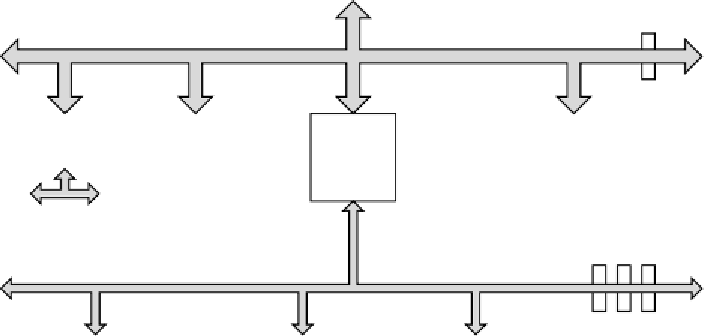Hardware Reference
In-Depth Information
and in 1995, PCI 2.1 came out. PCI 2.2 has features for mobile computers (mostly
for saving battery power). The PCI bus runs at up to 66 MHz and can handle
64-bit transfers, for a total bandwidth of 528 MB/sec. With this kind of capacity,
full-screen, full-motion video is doable (assuming the disk and the rest of the sys-
tem are up to the job). In any event, the PCI bus will not be the bottleneck.
Even though 528 MB/sec sounds pretty fast, the PCI bus still had two prob-
lems. First, it was not good enough for a memory bus. Second, it was not compat-
ible with all those old ISA cards out there. The solution Intel thought of was to de-
sign computers with three or more buses, as shown in Fig. 3-51. Here we see that
the CPU can talk to the main memory on a special memory bus, and that an ISA
bus can be connected to the PCI bus. This arrangement met all requirements, and
as a consequence it was widely used in the 1990s.
Cache bus
Local bus
Memory bus
Level 2
cache
PCI
bridge
Main
memory
CPU
PCI bus
Graphics
adaptor
SCSI
USB
ISA
bridge
IDE
disk
Available
PCI slot
Mon-
itor
Key-
board
Mouse
ISA bus
Sound
card
Available
ISA slot
Modem
Printer
Figure 3-51.
Architecture of an early Pentium system. The thicker buses have
more bandwidth than the thinner ones but the figure is not to scale.
Two key components in this architecture are the two bridge chips (which Intel
manufactures—hence its interest in this whole project). The PCI bridge connects
the CPU, memory, and PCI bus. The ISA bridge connects the PCI bus to the ISA
bus and also supports one or two IDE disks. Nearly all PC systems using this ar-
chitecture would have one or more free PCI slots for adding new high-speed
peripherals, and one or more ISA slots for adding low-speed peripherals.























